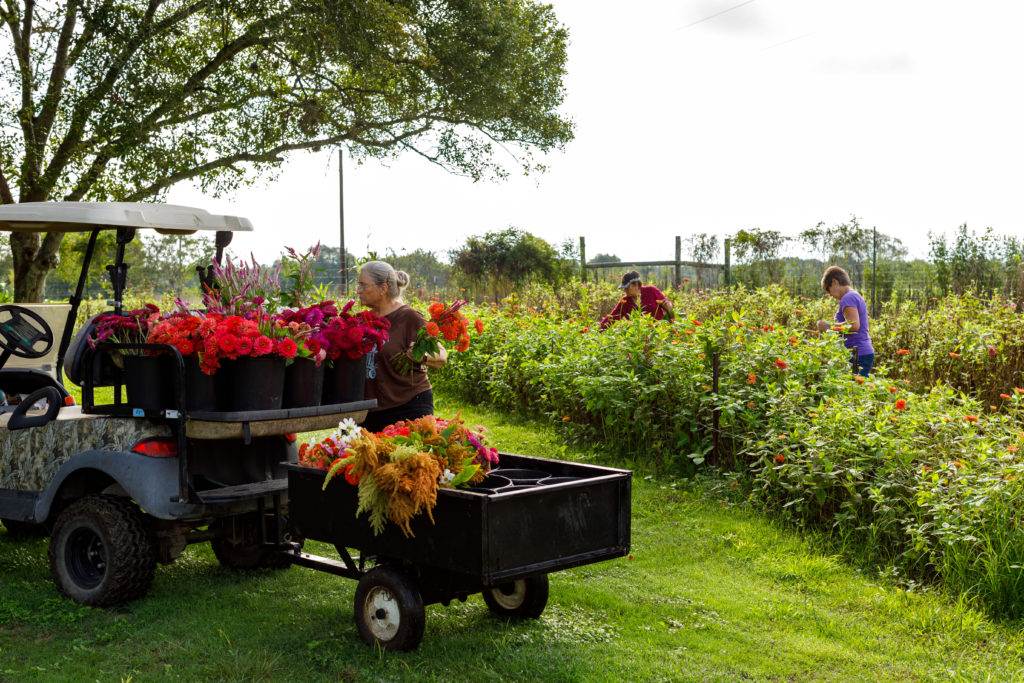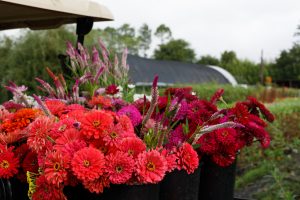Growing Happiness and Giving Joy
Rita Albers, owner of Cuts of Color flower farm near Weimar, specializes in growing happiness and giving joy.

2024 Spring Antiques Show | March 14 – 31
2024 Fall Antiques Show | October 10 – 27
Rita Albers, owner of Cuts of Color flower farm near Weimar, specializes in growing happiness and giving joy.

Rita Anders grows happiness at Cuts of Color near Weimar.
“Flowers bring joy,” said Rita, a lifelong resident of Weimar, who can see the silos of the farm where she was reared from her flower farm. “It’s the best thing about my job.”
And she’s not kidding.
I challenge you to keep from grinning ear to ear as I did when I walked up on the largest flower arrangement I’ve ever seen. The vase? A Kawasaki Mule® and trailer outfitted with plastic buckets. A profusion of zinnias, gomphrena, celosia, sunflowers and foliage such as mahogany hibiscus filled the containers. If my smile hadn’t been so big, the sight might have left me slack-jawed.
“Just so you know, September is our leanest month,” said Rita, explaining the flower farm is transitioning between warm season and cool season flowers. “Flowers are just like people. They get tired of the heat.”

Spring is her favorite season. Summer is her least favorite. I won’t be visiting in the spring because, if the flowers are truly more glorious, my oversized smile might just break my face.
Cuts of Color uses a combination of small-scale fields and greenhouses, to produce cut flowers throughout the year. Anders’ first greenhouse came from her grandfather, who raised hothouse tomatoes. Initially, Rita, who grew up on a dairy farm that also produced peaches and pecans, produced greenhouse tomatoes on the property she and her husband Edwin, also a Weimar native, purchased in 1983.
“Both my grandfathers were farmers. My dad was a farmer,” Rita said. “We’re not very good at working for other people. Well, except for God and Mother Nature—and they can be hard bosses.”
Anders’ children grew up working on the family’s farmstead.
“They worked alongside us all their growing-up years—that’s why none of them are here now,” Rita said laughing. “We raised flowers and another generation of entrepreneurs.”
Daughter Erin and her husband Jeff Glueck own and operate Glueck Tree Farm in Cat Spring. Son Jim and his wife Nikki own Traditions Pools and Landscapes in College Station. Son Brian and his wife Samantha recently purchased Mr. B Fireworks in Schulenburg.

“I’m proud of what they’ve accomplished with their own hard work,” Rita said.
Due in part to rising fuel costs, Rita diversified to include cut flowers. She phased out the tomatoes and began solely growing flowers in 2004. Anders primarily uses organic production methods. Chemical treatments are a last resort. If needed, they are applied sparingly and as a spot treatment.
“Growing flowers is different than growing tomatoes, but it’s still growing something,” Rita said.
A Flexible Foundation
Growing things requires flexibility.
“We’re working in reverse today—harvesting the fields first and then the greenhouses,” said Rita as she snipped zinnias along with the rest of her team. “Normally, we work in the greenhouses early before it gets hot—in the summer, the greenhouses run at least 10 degrees hotter than outside—and then move outside, but today we’re trying to beat the rain.”
Rain at a flower farm is a mixed blessing. While nothing quenches growing plants’ thirst like rainwater, the rain can pulverize the blossoms, and the wind accompanying a thundershower can wreak havoc. Normally, Rita relies on drip irrigation. A recent rain flattened an entire row of zinnias. The team propped them up in hopes the stems would straighten, strengthen and continue to produce blooms.
“When people are buying flowers, they only want the perfect ones; so we have to be selective—rain, heat and insects can all leave their marks,” Rita said. “We’re picking them extra close today, too. If we get the 5–7 inches like they’re predicting over the weekend, we won’t have any flowers worth picking on Monday.”
When the weather cooperates, the Cuts of Color crew harvests on Mondays and Thursdays and delivers bouquets to Central Market, located at 3815 Westheimer in Houston, on Tuesdays and Fridays. Rita got her spot in Central Market in 2012 by walking through the door and tracking down the manager. At the time, she had been setting up every Saturday morning for eight years at the Urban Harvest Farmers Market just around the corner. She and her business were both ready for a change.
“I wanted one consistent customer, and I wanted to get my weekends back,” Rita said. “Because of the farmers market, I knew what would grow, what would sell and I understood the clients and the demand.”
Armed with knowledge, a proven track record and the advantage of being locally grown, she struck a deal.

“By the time I got home that day, the paperwork was waiting for me on my computer,” Rita said. “We built our lives in Weimar, but we built our market in Houston.”
Today, Cuts of Color is front and center in the floral department. Signs prominently identify the company and trumpet its Texas roots, which align perfectly with HEB’s locally grown focus.
“Did you know about 80 percent of the fresh flowers purchased in the United States are imported?” Rita said. “Local flowers like ours are fresher and more vibrant. The varieties we grow touch people’s hearts because they often remind them of what their grandmothers grew. Plus, they don’t leave a carbon footprint—and when you buy local you’re supporting your local farmer.”
To fulfill a wholesale contract with a corporate giant like HEB, a small business has to have a consistent supply of product and a consistent team that can deliver the goods. At Cuts of Color the team includes Umparo, a full-time employee, as well as Christine, Melanie and Evelyn, who work part-time. They harvest in the mornings.
Each woman wields a pair of Fiskars scissors and cuts the stems long. Once their hands are full, they deliver the blossoms to the appropriate container on the ATV. When the mule is full, someone moves the filled containers to the shade where the women will gather after lunch to make bouquets. Then they repeat the process until the three acres allocated to flowers are harvested. In the summer Rita also hires local high school students to help.
“The people here make hard work easier,” said Rita noting they spent six hours the day before weeding muddy fields. “It’s pretty stress-free around here. It’s peaceful and quiet. We’re working in nature. We laugh a lot and enjoy each other’s company.”
The Cuts of Color team also includes Mario, who works full-time, as well as Edwin. After 39 years at Weimar’s MG Feeds, Edwin retired and now pitches in on the farm wherever he’s needed. He routinely performs construction and maintenance, runs farm errands and, if needed, bundles flower bunches. On this particular day he’s picking up a load of bone meal to be used on the farm.

“He makes it possible for me to stay on the farm and get my work done,” Rita said.
On Fridays, Edwin delivers to Central Market, so Rita can design bouquets for the weddings she’s booked. On the day I visited, she was creating 35 additional arrangements for a weekend wedding after finishing the bouquets for Central Market.
“My farmers market customers—and my friends—kept asking me to do weddings, so I went to some workshops, watched some people and taught myself how to design flowers.”
Her wedding design service was a hit.
“I said yes to a few weddings, and all of the sudden I was doing 45 weddings a year,” Rita said.
She maintained that pace for two years before limiting herself to no more than two weddings per weekend and by learning to say, “No.”
“Now I block out some weekends and just don’t take any events,” Anders said. She is involved in 30 weddings this year.
These days she strives to end her workday by 5 p.m. so she can enjoy activities with Edwin and their family. While the business is satisfying, the 60-year-old grandmother of 10 is not planning to operate Cuts of Color until she is planted.
“I’ve grown this business until it’s just what I want it to be,” Anders said. “While I don’t expect to ever retire, when I turn 65 things will change. I might run a cutting garden to supply the local market or teach workshops—and people are after to me to write a book. Who knows? I love my work here on the farm, but I also love living the life it has provided.”
_____________________________________________________________________________
Bloom Where You’re Planted
A Q&A with Rita Anders
RTR: What’s the best piece of advice you can give someone who wants to start a cut flower farm?
RA: Start small and figure things out before enlarging. Grow some flowers. Sell them to your friends and in your local community. See what you can grow. See what sells. Figure out how to get them to market.
Then find a larger audience. For me it was an urban farmers market. Refine all your processes. Ramp up your production. Learn to deliver a high volume of high-quality product. Make your big mistakes when the stakes aren’t so high.
Once you have it all sorted out, go land a wholesale customer. The big boys don’t give second chances, so you need to be able to do what you say you can. Of course, you’ll still make a few mistakes, but they won’t be the big ones that will cost you a contract.
RTR: What has been your best business decision?
RA: We paid as we went. I leased my first greenhouse from my grandfather when he quit growing tomatoes. We saved the money we made and then bought the greenhouse. We just kept repeating that process until we got where we wanted to be. It kept us from over committing. It kept us from getting too big too fast. And it kept us from getting crushed under the burden of a big loan.
A lot of people who I talk with, especially young farmers, think they need to jump right in with a big debt. Then they’re under constant pressure.
By building a piece at the time, I have always been able to run the farm instead of the farm running me.
_____________________________________________________________________________
Growing Happiness and Giving Joy
Cuts of Color Flower Farm
by Lorie A. Woodward
photos by Anna Spencer Morse, Grace Photography
2024 Spring Antiques Show | March 14 – 31
2024 Fall Antiques Show | October 10 – 27